Nepenthes Khasiana: A Pitcher Plant with Highland Flair
Hello, carnivorous plant enthusiasts! I’m Ferb Vu, and today we’re diving deep into the fascinating world of the Nepenthes Khasiana. This unique pitcher plant, endemic to the Khasi Hills of India, is a captivating addition to any collection.
Whether you’re a seasoned carnivore cultivator or just starting your pitcher plant journey, this FAQ will equip you with the knowledge to nurture this stunning Nepenthes.
Plant Family: Nepenthaceae – 207 Species in Genus Nepenthes
What are the distinguishing features of Nepenthes Khasiana?
The Nepenthes Khasiana boasts a mesmerizing array of characteristics. Here are some key features that set it apart:
- Pitchers: The most captivating aspect is undoubtedly the pitchers. These urn-shaped traps range from a vibrant green to a reddish hue and can reach up to 8 inches (20 cm) in height. The peristome, the rim of the pitcher, is adorned with distinctive fringed teeth, adding to its allure.
- Leaves: The foliage is another visual treat. The elongated, lance-shaped leaves showcase a leathery texture and come in various shades of green, often with reddish veins adding a touch of contrast.
- Size: Compared to some Nepenthes giants, the Khasiana is a more compact variety. It typically grows to around 12-18 inches (30-45 cm) in height, making it ideal for terrariums or smaller growing spaces.
How does Nepenthes Khasiana differ from Nepenthes Miranda?
Nepenthes Miranda, another captivating Nepenthes species, is often compared to the Khasiana. Here’s a breakdown of their key differences:
- Pitchers: Both boast beautiful pitchers, but with distinct styles. The Khasiana’s pitchers are more elongated and slender, with a prominent fringed peristome. In contrast, Miranda’s pitchers are broader and stockier, often featuring a more rounded lid (operculum).
- Coloration: The Khasiana typically displays a vibrant green to reddish color scheme, while Miranda showcases a wider range, including shades of yellow, orange, and even red.
- Growing Conditions: Both thrive in high humidity and moderate temperatures. However, Miranda can tolerate slightly lower temperatures compared to the Khasiana.
What are the ideal growing conditions for Nepenthes Khasiana?
The Nepenthes Khasiana is a highland Nepenthes, meaning it thrives in cooler temperatures than its lowland counterparts. Here’s a breakdown of its preferred environment:
- Temperature: Aim for daytime temperatures between 68-82°F (20-28°C) and nighttime temperatures dropping to 55-64°F (13-18°C).
- Humidity: High humidity is crucial. Ideally, maintain a range of 70-90%. Consider terrarium setups or employing humidifiers to achieve this level.
- Light: Bright, indirect light is ideal. Avoid harsh, direct sunlight.
- Watering: Use distilled or rainwater to avoid mineral buildup. The potting medium should be kept consistently moist but not waterlogged.
- Potting Medium: A well-aerated and draining mix is essential. A common option is a combination of sphagnum moss, perlite, and orchid bark.
How does Nepenthes Khasiana capture prey?
Like other Nepenthes, the Khasiana utilizes a passive trapping mechanism. The brightly colored pitchers and sweet-smelling nectar lure insects. The slippery rim and waxy interior cause them to lose their footing and tumble into the pitcher’s digestive fluid pool at the bottom.
Does Nepenthes Khasiana require feeding?
While these plants can obtain some nutrients from captured prey, supplemental feeding is not necessary for their survival. However, if you’d like to encourage pitcher production, you can offer occasional treats like bloodworms or crushed insects.
How do I propagate Nepenthes Khasiana?
Propagation can be done through various methods, including:
- Leaf cuttings: Take healthy leaves and plant them in a well-draining medium under high humidity.
- Basal shoots: If your plant produces basal shoots (new growth at the base), you can carefully separate and pot them individually.
- Tissue culture: This advanced technique is typically used by commercial growers.
Where can I acquire Nepenthes Khasiana?
Reputable carnivorous plant nurseries and online retailers often offer Nepenthes Khasiana. Be sure to choose a seller that prioritizes ethical sourcing and healthy plant practices.
Conclusion
The Nepenthes Khasiana, with its captivating pitchers and manageable size, is a wonderful choice for carnivorous plant enthusiasts. By understanding its specific needs and providing the right environment, you can cultivate this unique and rewarding Nepenthes in your collection.
If i die, water my plants!



